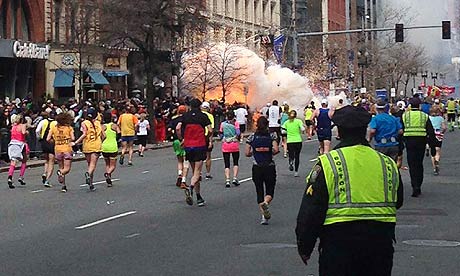
Boston Bombings & Ethical Dilemmas
March 15, 2015
Our very own need to consume details about events at a fast pace also presents us with ethical concerns. Social media is used for many good things, but it is also so new and in being such, we are all still learning what is acceptable and what we should deem unethical.
One of the events that helps draw this to the forefront is the Boston Bombings.
Whether we were in disbelief and needed proof that this really was occurring, or if we knew someone running and were worried about them, or if we were just at work and did not have access to a television, we relied on social media and the news organizations and even event attendees who were posting to networks like Twitter to give us information.
How would you feel if someone posted an image of your loved one covered in blood and in shock, laying on a Boston sidewalk? It would be a horrifying sight and not something that you would want anyone else to see.
I’m going to refrain from posting the image to my blog that we had to view and report on for class, because it is something that I wish I did not have to see. I am a squeamish person and the image was beyond grotesque. I will tell you that it was an image of a man who had his leg blown off and he was sitting in a wheel chair presumably being pushed somewhere to be attended to. With having his leg blown off, the photo showed things that nightmares are made of–things that movies try to emulate to make situations look real. But, this is real.
That is something that will never leave my mind.
How can that type of image be ethical for anyone to view? At what point does posting graphic photographs in real time really cross the line?
The social media world is comprised of people of all walks of life and this includes minors. Should they be exposed to something like that in their news feed?! If you had a child, would you want them to see that?
Perhaps if the world still expects to have all types of real time content posted without any types of ethical edits that a TV would have using a blur, a good idea would be to use a rating system when a user uploads an image much like modeling websites do. In the modeling world you have terms that generalize the photo as safe for everyone or if the modeling photographs are a bit risqué, there’s the option of selecting something like, “Not safe for work.” This would provide users the opportunity to select, “Safe for everyone,” or “May contain sensitive content,” when they are uploading photographs to social media. In the event that the image contains sensitive material, users would have the warning prior to having to see it without a warning.
Not only should we consider other people viewing the image, but what about the MAN in the image? Do you think that he would want such a devastating time of his life to be exploited online? We must assume that it could be the single worst thing that has ever happened to him, and here some people are just wanting to view the image to see the graphic nature of what that type of injury would look like. That man had no say in his image being taken or shared.
The event coordinator in me is also a little confused because when we want to use images of people at our events we need to have them sign a release or we have to post signs stating in the area which you are in is being filmed or photographed and by being in that area you are agreeing that your image and likeness can be used. If you are presumably reporting the news, does the need for a release seemingly disappear and anyone is able to be photographed?
In my frame of mind, I would be disgusted if someone shared an image of me like that. Where are people’s rights? There are so many ethical concerns that we can consider. The way we get news is changing and we need to establish some sort of boundaries.
Do you believe it is ethical to have these types of images distributed on social media? If you have shared disheartening photos such as this, what was your motivation?

Hi Megan – You definitely have a point here: “The social media world is comprised of people of all walks of life and this includes minors. Should they be exposed to something like that in their news feed?! If you had a child, would you want them to see that?” For this exact reason, I’m not sure I’m OK with seeing such brutality on the news on as a post from news organizations. Yes – I want to see the truth as ugly as it may be, but not something that is so graphic. I share your belief that news organizations should stick to reporting facts and stories. I also understand they are are competing for viewership and readership, but how much is too much? Great post! Thanks for your analysis.
Hi Aldona,
I think kids are exposed to violence and questionable things through movies and video games–but we can make an argument that those are “fake” scenarios. On social media, they would be exposed to something real. I do not have children so I do not know how a child would normally react to seeing something like that or if they would even be able to fully comprehend how extensive it is. At least with movies and video games, parents have the opportunity to consider the rating of the media and if it is suitable for their child. Social media does not afford that luxury so kids are exposed to anything and everything. Even for those of us who are old enough to see the most graphically rated movies does not mean that we want to see the images in real life. There’s fiction and then there’s reality. Me, personally, I do not want to subject myself to sensitive images or video because it is heartbreaking. Like you said, how much is too much?
Hi Megan,
Great, thought-provoking post. While I have been mostly advocating raw journalism and citizen journalists posting real-time images as they receive them, you brought up a great point: If that was me or one of my family members who was the subject of the post, would I want the world to see it? Honestly, by putting raw journalism and content into that perspective, I don’t think I would want a graphic photo of a family member being posted anywhere. By someone taking a photo of the event and posting that online, is that an invasion of privacy? Perhaps it is. But, it is also important to take into consideration that images are needed to tell stories and allow news to spread. While it would be unfortunate for you are a family member to be the subject of a graphic photo, that photo may be the one that the media needs to tell as story in order to get people involved to take action. Where does personal privacy stop for the greater good of society? It’s something that I feel we should all think further about. Thanks for bringing that up!
Hi Whitney,
Thank you! I know that the media has published horrific photos since the inception of a camera to tell a story–we can see this depicted in the history of war and even the numerous photos from Nazi concentration camps where bodies were stacked on top of one another. I guess from my perspective, the blood and the guts is where I feel things cross the line. Photographers are able to tell amazing stories through photos of concentration camps with the showing of the bodies being stacked and children behind barbed wire fences and they did not have to show up photographs of of charred bodies for us to know that they were also burned. I just think we can be just as effective with our storytelling through images that do not showcase limbs being blown off. I’m not suggesting we hide that at all–but maybe be more sensitive to the matter and be more creative with our storytelling so we can have the same points highlighted. You are right, we do need to think about the boundaries of personal privacy! Thanks for your response.
Hi Megan,
I enjoyed reading your post, mostly because I have the same stance as you on these situations. I feel like as sympathetic as we are to the people in the photos for what they experienced, what about the aftermath of the article and the story? As someone else stated in their post, what happens when the guy in the photo goes to google himself in 10 years from now? He will still have to carry the weight of that day with him forever, and now for everyone else to see. He will be forever associated with that image and that day. We are all learning together about how social media plays a role in our daily lives. I know that reporters have a job to sell a story, but with the way news can go viral so quickly, they should have to consider the implications of their story more than ever.
Hi Sami!
I think the key you and I are both looking at is just being more human and more sensitive to individuals. Yes, there are incredibly important events are are undoubtedly shaping our history and our culture but there are still people involved. There are still individuals who have to cope with life changing circumstances. This isn’t reality television where somebody signs up to have their personal details broadcast to the world. These people (as far as we are aware) have no say to what they have been subjected to. Does it make us inhumane to do that to someone? We’re disregarding their rights which is ethically wrong. But, in all technicality, how can it also be wrong when there aren’t any guidelines for how situations should be treated? Thanks for your observation, Sami!